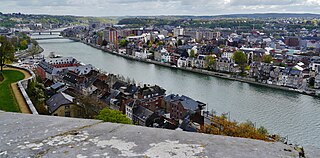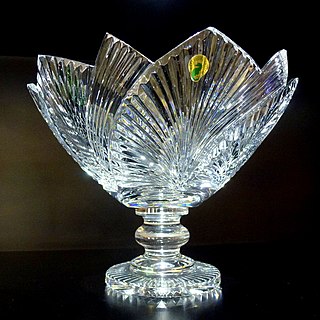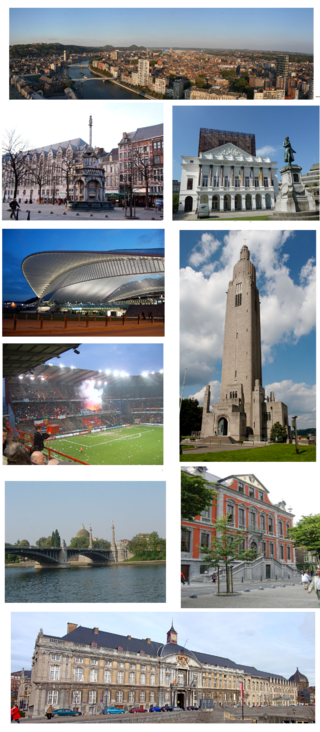
Val Saint Lambert is a Belgian crystal glassware manufacturer, founded in 1826 and based in Seraing. It has the royal warrant of King Albert II.[ citation needed ]

Val Saint Lambert is a Belgian crystal glassware manufacturer, founded in 1826 and based in Seraing. It has the royal warrant of King Albert II.[ citation needed ]
In 1795 during the War of the First Coalition which brought about the fall of the Dutch Republic, France had annexed what was then termed the Southern Netherlands, now known as Belgium. During the period of the Napoleonic Wars, in 1802 Napoleon Bonaparte asked French industrialist Henri D'Artigues to leave the noted French crystal maker Saint-Louis to buy the dilapidated glassworks at Vonêche. Like Saint-Louis, Vonêche produced lead crystal glass, and within ten years had become the most important crystal producer in the French empire. Two of the key workers in the plant's success were chemist François Kemlin and engineer Auguste Lelièvre. In 1815 following Napoleon's defeat at the Battle of Waterloo, the Southern Netherlands was re-united within the new United Kingdom of the Netherlands. As a result of newly imposed import duties, the Vonêche factory immediately lost most of its French market. In 1816, D'Artigues negotiated with King Louis XVIII of France to buy the Verrerie de St Anne glassworks in the town of Baccarat, and renamed it the Verrerie de Vonêche à Baccarat – a name it kept until 1843. The Belgian Revolution of 1830 meant that the Vonêche glassworks also lost most of its Southern Holland market, and hence closed soon afterwards. [1]
In 1825 Kemlin and Lelièvre bought the site of the former Val-Saint-Lambert Abbey in Seraing near Liège on the river Meuse. There they founded a new glassworks (still in operation to this day, originally focused on heavy lead crystal), which initially employed some of the key workers from the former Vonêche glassworks. [1] The two founders initially built two houses for themselves, and block accommodation for the acquired former Vonêche workers. Like similar highly religious employers, this policy of complete lifestyle development eventually led to the company building over 200 houses on the site to house workers, in what became a self-service village which also had a general store, school and post office; the local Roman Catholic church was also expanded to accommodate additional worshippers.
Due to the quality of its designs and manufacturing process, the company developed a well known brand and expanded. Aside from its home territory of Belgium and the Netherlands, the largest export market was to then Tsarist-ruled Russia. In 1876 the company opened a distribution base in New York, and in 1889 the company's CEO visited the store, and toured locally based competitor East Coast factories. As a result, on his return to Belgium the CEO noted in his report the then superior quality of American glass and the skill of its crystal cutters, which the company responded to by developing its own "bright" ranges and superior quality cutting. [2] The resulting "bright period" expanded the companies reputation and market especially in North America, and hence today it is well known and collected there for its Art Nouveau and Art Deco pieces. In 1894 at the world exhibition in Antwerp, the company manufactured an over 2 metres high vase consisting of 82 parts and weighing 200 kilograms, which is still intact and now on display at the Curtius Museum in Liège. As the company became more successful - at its height in the period 1900–1914, it employed over 5,000 workers creating 120,000 pieces of glass per day - the company contracted out work to other factories, [3] latterly either buying them or opening new factories, including: Jemeppe (1883 to 1952); two near Namur (1879 to 1935); and Jambes (1880 to 1931, producing oil glass lamps). [1]
The company stopped producing during World War I, and post-war after the Russian Revolution the market in Russia totally collapsed, resulting in financial difficulties and contraction. Exports to North America saved the company, but again it suffered difficulties with the collapse of that market post the Wall Street Crash of 1929. The company hence closed the Jambes and two Namur factories, and was stable by the time of World War II, during which like most of Belgium the factory was bombed by both the Nazi Luftwaffe and the Allied Air Forces of the RAF and USAAF. Production resumed initially in the less bomb-damaged Jemeppe factory until the production lines could be restored at Seraing, which resulted in the closure of the Jemeppe factory in the 1950s. Whilst many of the buildings at Seraing were restored, a large part of the site remained as was post-WW2 until the early 2000s, when these derelict 19th century buildings were cleared to create the modern steel-framed factory, visitor centre and small factory shop which exist today, together with the original restored 19th century factory offices. [4]

Baccarat is a commune in the Meurthe-et-Moselle department in the Grand Est region of north-eastern France.

Namur is a city and municipality in Wallonia, Belgium. It is the capital both of the province of Namur and of Wallonia, hosting the Parliament of Wallonia, the Government of Wallonia and its administration.

Seraing is a city and municipality of Wallonia located in the province of Liège, Belgium.

Waterford Crystal is a manufacturer of lead glass or "crystal", especially in cut glass, named after the city of Waterford, Ireland. In January 2009, the main Waterford Crystal manufacturing base on the edge of Waterford was closed due to the insolvency of Waterford Wedgwood PLC, and in June 2010, Waterford Crystal relocated almost back to the roots of glass-making in the city centre. The Mall location holds both a manufacturing facility that melts over 750 tonnes of crystal a year - although most Waterford Crystal is now produced outside Ireland - and a visitor centre with the world's largest collection of Waterford Crystal. As of 2015, the brand is owned by the Fiskars Corporation.
Lalique is a French luxury glassmaker, founded by renowned glassmaker and jeweller René Lalique in 1888. Lalique is best known for producing glass art, including perfume bottles, vases, and hood ornaments during the early twentieth century. Following the death of René, Lalique transitioned to producing lead glass (crystal) works during the 1950s while under the direction of René's son, Marc Lalique. Since 2010, Lalique has been owned by Swiss company Art and Fragrance.

Baccarat is a French luxury house and manufacturer of fine crystal located in Baccarat, Meurthe-et-Moselle, France. The company owns two museums: the Musée Baccarat in Baccarat, and the Musée Baccarat in Paris on the Place des États-Unis.

Liege Airport, previously called Liege-Bierset Airport, is an international airport located in Grâce-Hollogne, 5 nautical miles west of the city of Liège, Belgium. The airport mainly focuses on air freight. At the end of 2021, freight traffic reached 1,412,498 tonnes (+26%). Liege Airport is now the 5th biggest cargo airport in Europe and the 22nd biggest in the world.

Mirwart Castle is situated in Mirwart in Saint-Hubert, in the province of Luxembourg, Wallonia, Belgium.

Arc Holdings is the holding company of the Arc Group, specializing in the design and manufacturing of glass tableware. The Arc Group markets its collections in France and exports them abroad under the registered trademarks Luminarc, Arcopal, Cristal d’Arques Paris, Arcoroc and Chef&Sommelier. It also designs products for the private label and B2B markets.

Liège-Guillemins railway station is the main station in Liège, Belgium. It is one of the most important hubs in the country and is one of the four Belgian stations on the high-speed rail network. The station is used by 15,000 people every day, which makes it the eleventh-busiest station in Belgium and the third in Wallonia. It is operated by the National Railway Company of Belgium (SNCB/NMBS).

Wingen-sur-Moder is a commune in the Bas-Rhin department in Grand Est in north-eastern France. The name, literally translated as "Wingen on the Moder", is often shortened to Wingen, although this is the name of a small commune in the Haguenau-Wissembourg arrondissement.
Grönvik glasbruk or simply Grönvik was a glassworks in the present-day Grönvik village in Korsholm, Western Finland. It was founded by merchant Johan Grönberg and existed from 1812 to 1907. Several glass manufactures were produced at Grönvik. At first bottles and drinking-glass were made here, but beginning in the 1890s solely window glass. Also pharmaceutical glass was manufactured. The glassworks produced as the first factory in Finland pressed glass, which came about from the 1840s. The domestic market for glass was during the time of the glassworks smallish and glassblowing products were exported to e.g. Lübeck, Saint Petersburg, Stockholm and Denmark, as well as to other parts of Europe. Grönvik was able to successfully assert its position, despite the competition from other glassworks in Finland. Eventually, it became the most distinguished in the country. The glassworks also become the largest in the Nordic countries.

Liège is a city and municipality of Wallonia and the capital of the Belgian province of Liège. The city is situated in the valley of the Meuse, in the east of Belgium, not far from borders with the Netherlands and with Germany. In Liège, the Meuse meets the river Ourthe. The city is part of the sillon industriel, the former industrial backbone of Wallonia. It still is the principal economic and cultural centre of the region.

Val-Saint-Lambert Abbey was a Cistercian abbey in the Prince-Bishopric of Liège. It is situated in the Walloon municipality of Seraing, on the right bank of the Meuse, in Belgium, about 13 km (8.1 mi) south-west of Liège. Founded in 1202, the abbey's monks were expelled during the French Revolution. In the 19th century, the building ruins were converted into the Val Saint Lambert crystal factory. The structure is considered to be an important example of Cistercian architecture.

Namur railway station is the main railway station serving Namur, Belgium. The station is used by 18,600 people every day, making it the eighth-busiest station in Belgium and the busiest in Wallonia. It is operated by the National Railway Company of Belgium (SNCB/NMBS).

Chênée is a sub-municipality of the city of Liège located in the province of Liège, Wallonia, Belgium. It was a separate municipality until 1977. On 1 January 1977, it was merged into Liège.